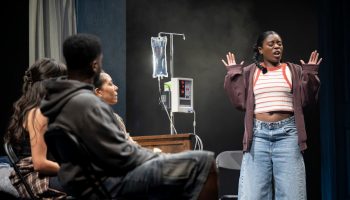
Gabriel Weber
Staff writer
Grammy-nominated composer Missy Mazzoli believes composing provides an opportunity to express the inexpressible.
“Composing is a way of engaging with the world in a very deep way,” Mazzoli said. “It’s a way of connecting with other people and a way to give voice to things for which we have no words — it’s like the space between emotions.”
Mazzoli’s “Sinfonia (for Orbiting Spheres)” will open the Chautauqua Symphony Orchestra: Celestial Dances concert at 8:15 p.m. tonight in the Amphitheater. The piece’s form was literally written in the shape of a solar system, with the rotations of the planets fitting into revolutions around the sun that combine to form even bigger loops.
Following “Sinfonia (for Orbiting Spheres),” will be Manuel de Falla’s El Amor Brujo and Igor Stravinsky’s “Pulcinella Suite,” performed by the CSO and led by Music Director and Principal Symphonic Conductor Rossen Milanov.
According to Milanov, de Falla was “one of the important composers at the beginning of the 20th century.”
“Although it is a full-blown ballet,” Milanov said, “it’s a piece that can be performed without necessarily having to follow the plot.”
The tale follows a young widow, who has a new lover, and is haunted by a jealous — and dead — husband. The widow and her lover go on to perform a series of rituals for freedom, and in the end, it turns out the husband was not even faithful to her: He had an affair with another woman.
“It is intense in a very Spanish way, with the idea of real and superstitious, but at the same time, it’s this incredibly vital music, music full of love and life,” Milanov said. “The music is full of even exoticism, in a certain way, because Flamenco is always something that always comes across as something quite distilled and passionate.”
Though Stravinsky’s ballet Pulcinella premiered in 1920 and the “Pulcinella Suite,” a distilled version of the ballet, premiered two years later, “if you had just turned on the radio, then you would think you were listening to a piece from the 1700s — it doesn’t sound like what you might imagine,” Concertmaster Sharon Roffman said.
She has a violin solo in this piece that is often used as an excerpt for orchestra auditions, which “shows its level of difficulty,” Roffman said, though it also makes it feel “a bit more familiar.” While there are many smaller solos surrounding Roffman’s, the speed and the fact that her solo is “all over the place” makes it challenging.
For the ballet itself, Picasso did the original backdrops, and audiences can “almost hear the style of Picasso’s work,” Roffman said. “Pulcinella Suite” is “really like looking at a Picasso painting; it’s got both heartfelt moments and jagged edges,” she said.
Mazzoli is artist-in-residence here at Chautauqua, composing an operatic adaptation with librettist Royce Vavrek of George Saunders’ Lincoln in the Bardo, which was commissioned by and will premiere at The Metropolitan Opera in 2026. She was also at Chautauqua nine years ago when the Opera Company performed her first opera, Song From the Uproar: The Lives and Deaths of Isabelle Eberhardt.
Milanov and Mazzoli have known each other for several years, and he has performed Mazzoli’s work on several different occasions. While Mazzoli is “extremely successful,” specifically in the operatic scene, Milonov said, “Sinfonia” is “the orchestral work that literally put her on the map as a symphonic composer.”
Known for her inventiveness, Mazzoli has added a few extra instruments in her “Sinfonia (for Orbiting Spheres).” Eight players, in addition to playing their instruments, will play harmonicas; also, a percussionist will use a melodica, which is like a plastic toy piano that sounds similar to a harmonica.
“(The sound of the harmonica and strings) makes me think of the music of the spheres, like this ancient idea that the moving of the planets made a noise we could actually hear if we listened closely enough,” Mazzoli said. “I love that idea, of what would that sound like?”
“Sinfonia (for Orbiting Spheres)” has this “feeling of nostalgic longing mixed with a sort of exuberance and a sort of other worldliness,” she said. It begins with a neo-Baroque feel, she said, that’s contemplative and dreamy until a spinning dance-like texture emerges. Then it returns to its origin.
Inspired by the geometry of the natural world, Mazzoli finds that from the initial idea of the shape of a solar system, ideas spring from ideas.
“It’s like the piece sort of builds itself fragment by fragment — it feels like it takes on a life of its own,” Mazzoli said. “It’s almost my favorite part of composing, when it’s not like I’m writing the piece, but like I’m discovering it. I’m kind of revealing it to myself. You have to have something to go on and then also let your ear guide you.”
Mazzoli has called herself a composer since she was 10 years old, playing piano and writing music.
“It happened very young for me; it just is something that allows me to investigate everything on earth,” Mazzoli said. “I can investigate literature and math and philosophy and nature and history and all these things, and then all that feeds my composition.”
Seeing this form of creation as a way to process the world, Mazzoli feels that music can be a better way to understand reality.
“Composing is my way of literally making sense of the chaos of the world,” Mazzoli said. “I am taking whatever vague inspiration I have and putting it into a grid on the page of music and giving it order — that’s very satisfying.”




